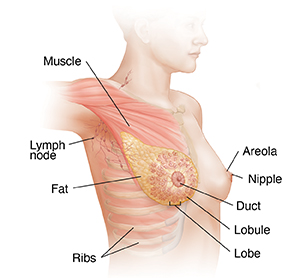Normal Breast Development
What is normal breast development?
Breast development is a vital part of puberty in females. It occurs in stages: first before birth, then during puberty, and then again during the childbearing years. Changes also occur to the breasts during menstruation and when a woman reaches menopause.
When does breast development start?
Breasts start to form while the unborn baby is still growing in the mother’s uterus. This is when a thickening in the chest area called the mammary ridge or milk line develops. By the time a baby girl is born, nipples and the start of the milk-duct system have formed.
Breast changes continue over a woman’s life. The first thing to develop are lobes, or small subdivisions of breast tissue. Mammary glands develop next. These are made up of 15 to 24 lobes. Mammary glands are influenced by hormones activated in puberty. Shrinkage (involution) of the milk ducts is the final major change that occurs in the breast tissue. The mammary glands slowly start to shrink. This often starts around age 35.

What breast changes happen at puberty?
As a girl reaches puberty, the first visible signs of breast development start to show. When the ovaries start to make and release (secrete) estrogen, fat in the connective tissue starts to build up. This causes the breasts to enlarge. The duct system also starts to grow. Often, pubic and underarm hair also appear at this time.
Once ovulation and menstruation start, the breasts begin to mature and glands form at the end of the milk ducts. The breasts and duct system continue to grow and mature with the development of many glands and lobules. The rate of breast growth varies and is different for each young woman. Generally, there are 5 stages of breast development in girls.
Female Breast Developmental Stages | |
Stage 1 | Preteen. Only the tip of the nipple is raised. |
Stage 2 | Buds appear, and breast and nipple are raised. The dark area of skin around the nipple (the areola) gets larger. |
Stage 3 | Breasts are slightly larger, with glandular breast tissue present. |
Stage 4 | The areola and nipple become raised and form a second mound above the rest of the breast. |
Stage 5 | Mature adult breast. The breast becomes rounded and only the nipple is raised. |
What cyclical changes happen to the breasts during menstruation?
Each month, women have hormone changes that make up the normal menstrual cycle. Estrogen is made by the ovaries in the first half of the menstrual cycle. It stimulates the growth of milk ducts in the breasts. The increasing level of estrogen leads to ovulation halfway through the cycle. In the second half of the cycle, the hormone progesterone takes over. It stimulates the formation of the milk glands. These hormones are believed to be responsible for the cyclical changes that many women have in their breasts just before menstruation. These include swelling, pain, and soreness.
During menstruation, many women also have changes in breast texture, with breasts feeling lumpy. These are the glands in the breast enlarging to get ready for a possible pregnancy. If pregnancy does not occur, the breasts return to normal size. Once menstruation begins, the cycle starts again.
Connect with us:
Download our App: